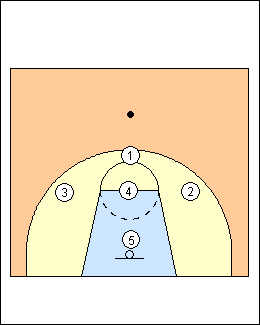 | 1 Basketball Highway With the ball up top, the point covers the width of the lane up top of the circle. The wingmen overplay to prevent the ball from being penetrated to the corners with one pass. The middle man of the zone protects the lane and the bottom defender protects the basket at all costs. Use a zone defence - to change the rhythm of the game - increase your ability to create a fast break game - against a poor shooting team - to protect a player in foul trouble (especially in the low post, where a second zone defender can pinch down more quickly to double team and force a kick out) - when you are getting beat by special plays - against a great point guard (get the ball out of his hands). |
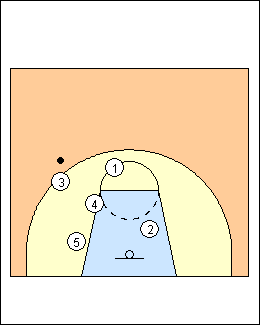 | 2 With the ball on the wing, 3 steps up to pressure the ball and close down the passing lane to the corner, but should not go beyond the top of the circle unless you are playing the extended 1-3-1 and trapping late in the game where you must have the ball. The bottom defender will move with the ball on the pass but will not go out to the corner until a pass is made there (the bottom man should line up vertically with the ball, so that when it's out front he is under the basket). The weakside wing protects the basket weakside and the middle man eliminates all passes into the paint. The point overplays the reversal pass and pinches the high post from the top. Steve Klass - Always have four defenders ballside. All defenders watch the eyes of the passer, arms out, move while the ball is in the air, five defenders rebound mad on a shot. Normally pick up the ball with a wing, 5 is one step off the lane, 1 covers ball reversal. |
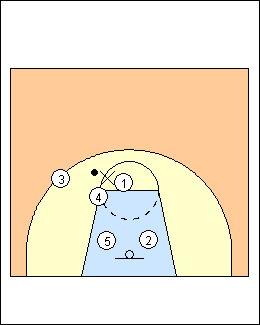 | 3 If the ball is passed to the high post the middle man must squeeze the high post and pressure an attacker who attempts to turn and square up to the basket. The point man digs back into the ball and the wings attempt to cover any lateral passes either high or low to the corners. The bottom man covers anything near the basket, and is on a vertical line with the ball. |
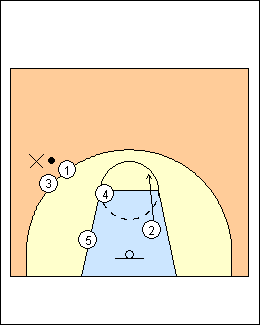 | 4 Trapping on the wing. You may gamble and have 2 deny a pass to the weakside wing (coachesclipboard.net). |
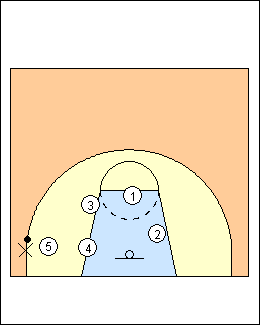 | 5 When the ball is in the corner, the bottom man must now move out to pressure as the ball arrives. The ballside wing covers the passing lane back out, or to the high post so that no direct pass may penetrate the zone. The weakside wing must then become basket coverage. Defenders must move on each pass with their hands up. Don't chase quick passes but keep somewhat compact until they can arrive at the attacking player with enough time to put pressure on the ball, and so that their teammates may shut down the direct penetrating passes to the zone. If you can slide quickly enough you may then exercise trap options. Don't get caught trapping when you are out of position. |
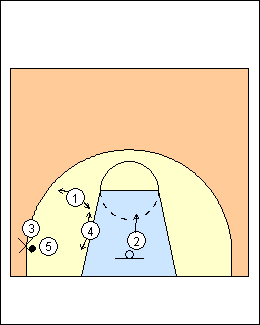 | 6 Trapping in the corner. |
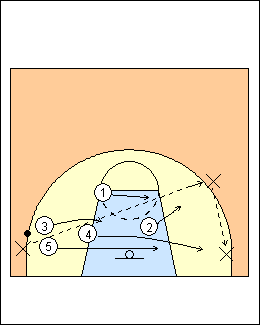 | 7 The exception to normal shifts is a diagonal skip pass to the wing with a second pass to the corner. 4 is closer to the weakside corner, so 4 and 5 slide switch, with 4 taking the corner and 5 covering the low to mid post. 4 must be able to close out quickly and take away baseline penetration, but not over-anticipate the corner pass. 2 quickly closes out on the wing then closes down on the pass to the corner. 1 sprints to cover the elbow. Steve Klass - 2 gets on the high hip of the ballhandler in the corner until 5 arrives, can then stay there or drop off into the passing lane (the base or default). Defenders at the elbow and low post complete the strongside box. |
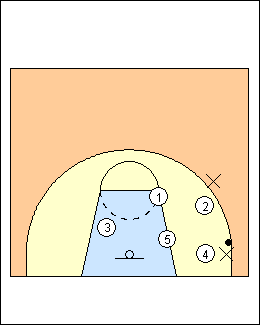 | 8 Instead of trapping in the corner, the ballside wing can cover a pass back out (Steve Klass) or cover the ballside elbow (coachesclipboard.net). |
This page was made with Basketball playbook from Jes-Soft